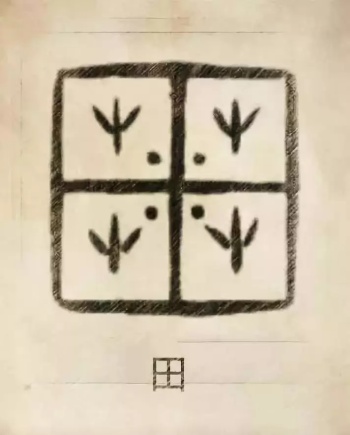The Tian(tián) surname is one of the oldest surnames in China, with a rich and legendary history. Its origins are diverse, reflecting the complex of Chinese culture and history. Let’s explore the fascinating story of the Tian surname, from its ancient roots to its modern significance.

Ⅰ、Origins of the Tian Surname:
1. The Gui Clan Legacy
The most widely accepted origin of the Tian surname traces back to the descendants of Emperor Shun, a legendary ruler in ancient China. During the early Western Zhou Dynasty (1046–771 BCE), Gui Man, a descendant of Emperor Shun, was granted the territory of Chen (modern-day Huaiyang, Henan). His descendant, Chen Wan, fled to the state of Qi to escape political turmoil and was granted the land of "Tian" by Duke Huan of Qi. Chen Wan’s descendants adopted "Tian" as their surname. This branch of the Tian clan rose to prominence during the Warring States period (475–221 BCE), when Tian He replaced the ruling Jiang clan of Qi, an event known as "Tian Clan Replacing Qi" . This marked a pivotal moment in the history of the Tian surname.
2. Official Titles and Zhou Dynasty Influence
The Tian surname also emerged from official titles during the Zhou Dynasty. The roles of "Tian Pu", who managed wooden roads for royal use, and "Tian Zheng" , who oversaw agriculture, were highly respected. Descendants of these officials adopted "Tian" as their surname, reflecting the influence of Zhou Dynasty rituals on Chinese surname culture.
3. Geographical Origins
During the Spring and Autumn period (770–476 BCE), place names such as Xu Tian in the state of Lu, Sang Tian in the state of Guo, and Xin Tian in the state of Jin became sources of the Tian surname. For example, Xu Tian was a sacred site for royal ceremonies, and those who managed the land adopted "Tian" as their surname.
4. Name Changes for Survival
During the Ming Dynasty (1368–1644), Huang Zicheng, a high-ranking official, advocated for reducing the power of regional princes, which led to the Jingnan Campaign. His son changed his surname to Tian Zhong to avoid persecution, and his descendants continued the Tian surname, primarily in Hubei and Beijing.
5. Ethnic Integration
The Tian surname also appears among various ethnic groups, including the Xiongnu, Jurchen, and Tujia peoples. For example, during the Jin Dynasty (1115–1234), the Jurchen A’buhai clan adopted the Tian surname as part of their Sinicization.
Ⅱ、Historical Figures:
1. Warring States Era
Tian Ji: Known for his wisdom in the "horse racing strategy," Tian Ji was a brilliant military strategist.
Tian Wen (Lord Mengchang): One of the Four Lords of the Warring States, he was renowned for his generosity and patronage of scholars, hosting thousands of guests at his estate.
2. Han Dynasty Scholarship
Tian He: A key figure in the development of the New Text School of Confucianism, Tian He played a crucial role in preserving and interpreting classical texts.
3. Tang Dynasty Power Brokers
Tian Chengsi and Tian Yue: Father and son who controlled the Weibo military district, significantly influencing the political landscape of the late Tang Dynasty.
4. Ming and Qing Dynasties
Tian Wenjing: A pragmatic reformer during the Qing Dynasty, Tian served as the governor of Henan and implemented the "Equal Distribution of Land Tax" policy, earning the trust of Emperor Yongzheng.
5. Modern Contributions
Tian Han: A pioneer of modern Chinese drama, Tian Han composed the lyrics of "March of the Volunteers," which later became China’s national anthem. His works inspired a sense of national pride and resilience.
Ⅲ、Cultural Significance:
1. Generational Names:
The Tian family uses generational names to pass down ethics and culture. For example, the Tian family in Jingzhou, Hubei, uses the sequence (Xiáng shǔ guāng huī xīng dǒu jí, qìng yún mián yuǎn lè shēng píng), which reflects reverence for nature and Confucian values.
2. National feelings in historical allusions
The story of Huang Zicheng’s descendants changing their surname to Tian highlights the survival strategies of scholar-official families during political upheaval. The Tian Yi Tomb in Beijing, with its intricate carvings, offers insights into the complex history of eunuch power during the Ming Dynasty.
3. The Symbol of Unity: The Purple Hall
The Tian family’s ancestral hall, known as the "Purple Hall" , derives from a story about the Tian brothers and a withering purple jasmine tree, symbolizing the importance of family unity.
Ⅳ、Social Impact: Migration and Modern Contributions
1. Migration and Distribution
The Tian surname was initially concentrated in the Yellow River Basin. During the Han Dynasty, the "Migration of the Powerful" policy spread the Tian clan to the Guanzhong region. By the Tang and Song Dynasties, they had migrated south to the Yangtze River Basin. During the Ming and Qing Dynasties, the Tian clan expanded further to southwestern China, Taiwan, and overseas. Today, the largest Tian populations are found in Hebei, Henan, Shandong, and Guizhou.
2. Contemporary Population and Achievements
With a population of approximately 5.2 million, the Tian surname continues to make significant contributions in agriculture, technology, and the arts. Notable figures include Olympic diver Tian Liang and writer Tian Er.
3. A Microcosm of Chinese Surname Culture
The Tian surname exemplifies the evolution of Chinese surnames from simple bloodline markers to multidimensional cultural symbols, reflecting the harmonious diversity of Chinese civilization.
Conclusion
The thousand-year history of the Tian surname is a microcosm of Chinese civilization—from the legendary Emperor Shun to the intellectual ferment of the Warring States period, from the migrations of scholar-official families to modern transformations. Whether through the wisdom of Tian Ji, the artistic passion of Tian Han, or the everyday labor of farmers, the Tian surname has consistently contributed to the construction of Chinese culture. It is not merely a bond of blood but a cultural gene, carrying the spirit of resilience, wisdom, and innovation.